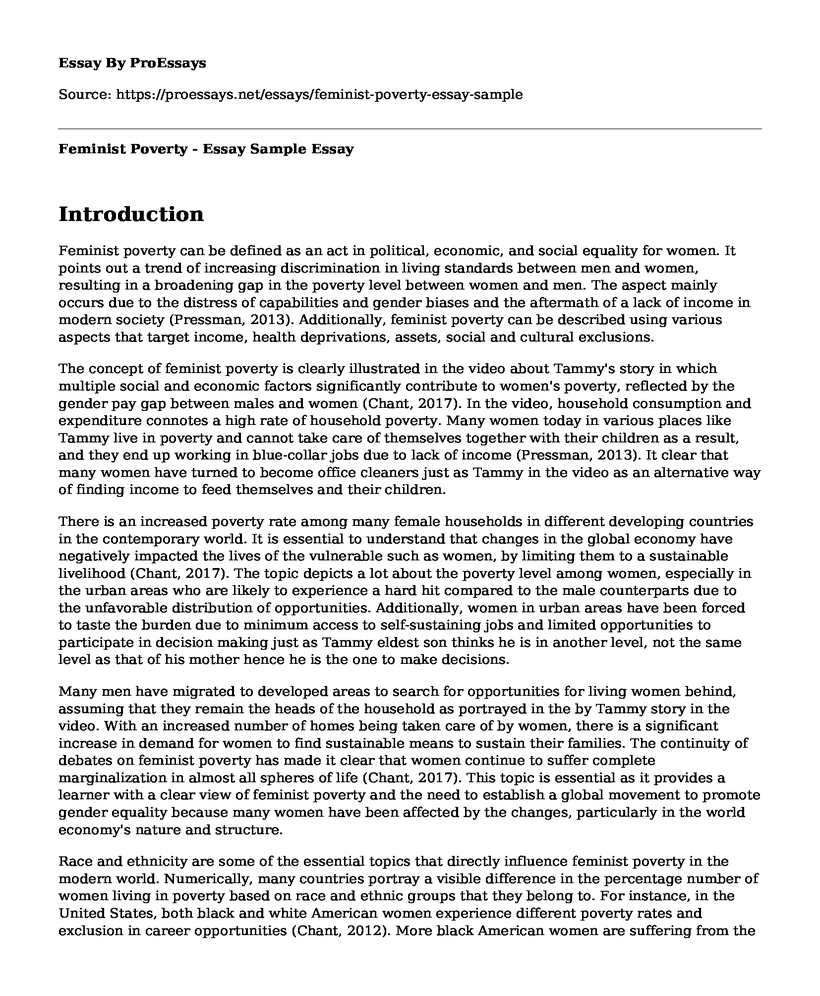Introduction
Feminist poverty can be defined as an act in political, economic, and social equality for women. It points out a trend of increasing discrimination in living standards between men and women, resulting in a broadening gap in the poverty level between women and men. The aspect mainly occurs due to the distress of capabilities and gender biases and the aftermath of a lack of income in modern society (Pressman, 2013). Additionally, feminist poverty can be described using various aspects that target income, health deprivations, assets, social and cultural exclusions.
The concept of feminist poverty is clearly illustrated in the video about Tammy's story in which multiple social and economic factors significantly contribute to women's poverty, reflected by the gender pay gap between males and women (Chant, 2017). In the video, household consumption and expenditure connotes a high rate of household poverty. Many women today in various places like Tammy live in poverty and cannot take care of themselves together with their children as a result, and they end up working in blue-collar jobs due to lack of income (Pressman, 2013). It clear that many women have turned to become office cleaners just as Tammy in the video as an alternative way of finding income to feed themselves and their children.
There is an increased poverty rate among many female households in different developing countries in the contemporary world. It is essential to understand that changes in the global economy have negatively impacted the lives of the vulnerable such as women, by limiting them to a sustainable livelihood (Chant, 2017). The topic depicts a lot about the poverty level among women, especially in the urban areas who are likely to experience a hard hit compared to the male counterparts due to the unfavorable distribution of opportunities. Additionally, women in urban areas have been forced to taste the burden due to minimum access to self-sustaining jobs and limited opportunities to participate in decision making just as Tammy eldest son thinks he is in another level, not the same level as that of his mother hence he is the one to make decisions.
Many men have migrated to developed areas to search for opportunities for living women behind, assuming that they remain the heads of the household as portrayed in the by Tammy story in the video. With an increased number of homes being taken care of by women, there is a significant increase in demand for women to find sustainable means to sustain their families. The continuity of debates on feminist poverty has made it clear that women continue to suffer complete marginalization in almost all spheres of life (Chant, 2017). This topic is essential as it provides a learner with a clear view of feminist poverty and the need to establish a global movement to promote gender equality because many women have been affected by the changes, particularly in the world economy's nature and structure.
Race and ethnicity are some of the essential topics that directly influence feminist poverty in the modern world. Numerically, many countries portray a visible difference in the percentage number of women living in poverty based on race and ethnic groups that they belong to. For instance, in the United States, both black and white American women experience different poverty rates and exclusion in career opportunities (Chant, 2012). More black American women are suffering from the effects of poverty than whites and Hispanics. There is a much big pay gap between white men and white women, with black women working for more hours than white women regardless of being paid less. However, most women in the world earn an almost equal amount of money irrespective of racial and ethnic background (Chant, 2012). It is important to note that historically, white women were unable to own property or instead work for themselves, hence they have always played the role of the employer over black women.
References
Chant, S. H. (2017). Gender, generation and poverty. Exploring the feminization of poverty in Africa, Asia and Latin America. Edward Elgar Publishing.
Chant, S. (2012, February 29). Feminization of poverty. The WileyBlackwell Encyclopedia of Globalization. Retrieved from https://onlinelibrary.wiley.com/doi/abs/10.1002/9780470670590.wbeog202
Pressman, S. (2013, July 2). Feminist explanations for the feminization of poverty. Economic Issues. Retrieved from https://www.questia.com/.../feminist-explanations-for-the-feminization-of-poverty
Cite this page
Feminist Poverty - Essay Sample. (2023, May 19). Retrieved from https://proessays.net/essays/feminist-poverty-essay-sample
If you are the original author of this essay and no longer wish to have it published on the ProEssays website, please click below to request its removal:
- Report Example on The Social Life of Small Urban Spaces by William H. Whyte
- A Literary Essay Example: Irony in Counterparts by James Joyce
- Migration of African-Americans vs. the Migration of Mexicans Into the US
- The Effects of 9/11 Attack - Paper Example
- Article Analysis Essay on Adolescents and Youth Offending, Antisocial Behavior, Victimization, Drug Use
- Essay Example on Urban Poverty, Crime & Wilson's Theory: Racial Dynamics at Play
- Paper Example on Exploring Stigma Impacts on Adolescents' Self and Relationships







